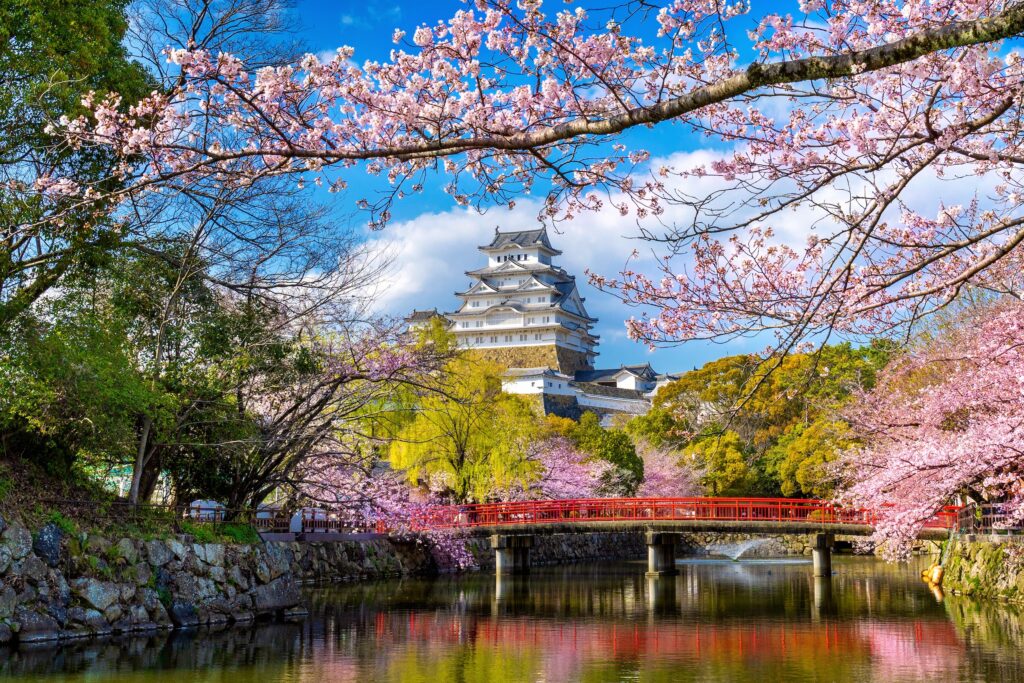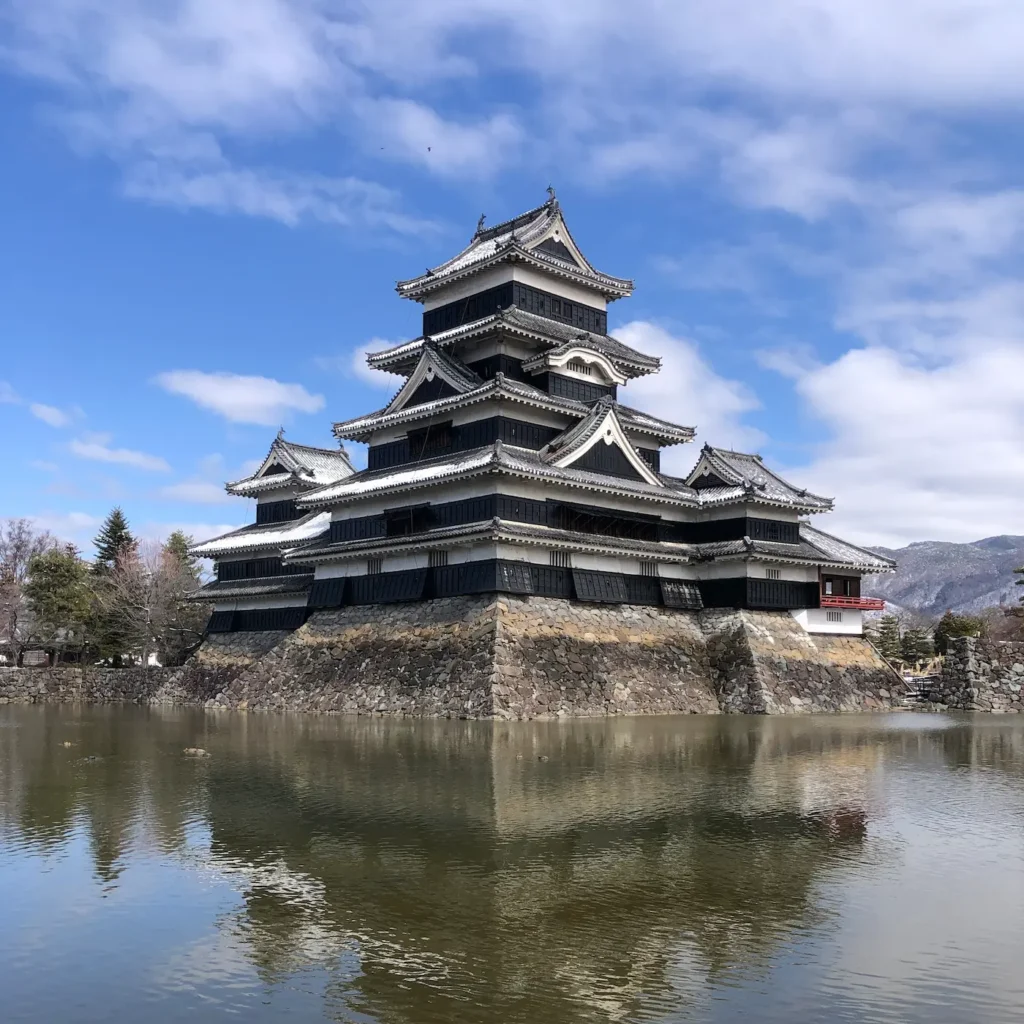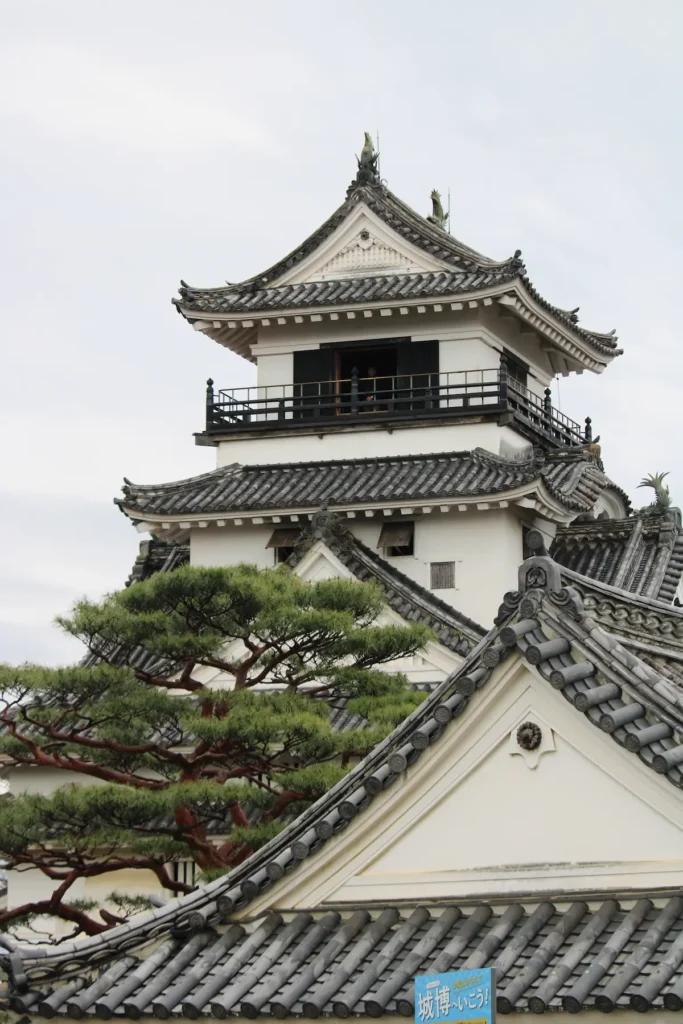There are around 100 castles in Japan, most of which were built between the 15th and 17th centuries. Centres of political, military and administrative power, they have withstood civil wars, clan attacks, internal rebellions and devastating fires. During the turbulent Sengoku period, they offered defence and strategic control, and in the Edo period, they symbolised authority and stability. Many of these castles are more recent reconstructions of earlier buildings, and only 12 originals remain, meaning they still have their original tenshu (天守) or main tower.
Below are some suggested itineraries you can follow to enjoy these architectural wonders on your trip to Japan.

Golden Castle Route: From the Black Raven to the White Heron
In other words, from Matsumoto Castle in Nagano to Himeji Castle in Hyōgo. These are perhaps the two most important castles in the country, and they mark the beginning and end of this route, which takes you to a total of five castles, travelling comfortably by train from Tokyo, Osaka or Kyoto.
Matsumoto Castle (松本城)
Starting the castle route in Matsumoto is a great way to begin. To reach this pleasant city in Nagano, you can take a Limited Express train from Tokyo (Tokyo or Shinjuku station) and in approximately two and a half hours you will be in Matsumoto. The castle is easily accessible, just a 15-minute walk from the station. Built at the end of the 16th century, it is one of Japan’s 12 original castles. Its six-storey main tower is made entirely of wood. It is nicknamed the Crow Castle because of its black colour, a nickname that is sometimes also applied to Bitchū-Matsuyama in Okayama. It is one of the oldest flatland castles (hirajiro) in Japan, built on flat ground (not on a hill), which is unusual for defensive castles. It is open to visitors, with exhibitions of samurai weapons, armour and panoramic views of the Japanese Alps from the top.

Castillo de Nagoya (名古屋城)
En nuestra ruta desde Matsumoto hasta Himeji haremos una segunda parada en Nagoya, una enorme ciudad con muchos atractivos, que no suele incorporarse en la ruta dorada de Japón y que tiene unas comunicaciones excelentes. El Castillo de Nagoya, construido en 1612 por orden de Tokugawa Ieyasu, fue un símbolo del poder del shogunato y es uno de los 12 castillos originales de Japón. Destaca por sus famosos ornamentos dorados de delfines (kinshachi) en el tejado. Aunque destruido en la Segunda Guerra Mundial, fue reconstruido y es uno de los castillos más emblemáticos de Japón.
Hikone Castle (彦根城)
An hour’s train ride from Nagoya takes us to Hikone Castle, strategically located near Lake Biwa in Shiga Prefecture. Its architecture stands out for its combination of different roof styles and a highly effective defensive layout, with moats, walls and hidden passages. The complex includes gardens, fortified gates and a museum. Surrounded by cherry blossoms in spring, it offers panoramic views and a unique atmosphere. It is also an original castle.
Osaka Castle (大阪城)
We continue our journey westward by train on the Tokaido Line, and our next stop is Osaka. Its castle, built in 1583 by Toyotomi Hideyoshi, is one of Japan’s most iconic historical monuments. It played a key role during the Sengoku period and was destroyed during the siege of 1615. Rebuilt in 1931, it now houses a museum. It is surrounded by a large park with cherry trees, and its tower offers fantastic panoramic views of the city. An interesting fact about this building is that it was partly financed by donations from citizens during its reconstruction, which highlights its importance as a symbol of the city. It is undoubtedly a must-see in Osaka.

Castillo de Himeji (姫路城)
We reach the end of our route in Himeji, easily accessible from Osaka on a day trip, during which we also recommend a visit to Engyō-ji Temple on Mount Shosha, north of the city. Himeji Castle, also known as Shirasagi-jō or White Heron Castle, is one of the most beautiful and best-preserved castles in Japan. Its elegant white structure is reminiscent of a heron in flight. Originally built in the 14th century and expanded in the 17th century, it has never been destroyed by war, earthquake or fire. A UNESCO World Heritage Site, it is an excellent example of Japanese feudal architecture, and its wooden interior offers an authentic experience of Japan during the samurai era.
Shikoku Castle Route

The island of Shikoku is home to four of Japan’s twelve original castles, providing an excellent excuse to explore this authentic and peaceful island. Matsuyama Castle, located in Ehime, is one of the largest and best preserved. Built in the 17th century, it stands out for its samurai architecture and gardens, as well as offering panoramic views from its main tower, located on top of a hill. Also in Ehime is Uwajima Castle, which combines samurai architecture with maritime influences due to its coastal location, and features a ninja kuruwa, a small special fortified enclosure designed for espionage and stealth defence activities. In northern Shikoku is Marugame Castle in Kagawa, notable for its imposing stone tower, one of the few remaining in Japan.

Kōchi Castle, in Kōchi Prefecture, is known for its wooden main tower and unique drawbridge. Also built in the 17th century, the castle retains many of its original buildings and offers fantastic views of the entire city.
It is one of the few Japanese castles that was never destroyed, either by war or fire, which means that its original wooden and stone structure has remained almost intact to this day.
Other castles worth visiting
Kumamoto Castle, built in 1607 by Katō Kiyomasa, is one of the most impressive castles in the country, famous for its enormous curved walls and its role in the Satsuma Rebellion. In Aomori Prefecture is Hirosaki Castle, which retains its original tower and is famous for its cherry blossom festival, with more than 2,500 trees surrounding its moats. In Shimane is Matsue Castle, stronghold of the Matsudaira clan, which retains its original wooden tower and offers beautiful views of Lake Shinji. Bitchū Matsuyama Castle in Okayama is the tallest original castle in Japan. Near the golden route between Matsumoto and Himeji is Fukui Castle, the oldest of the original castles.
Another great architectural complex is Kanazawa Castle, located in Ishikawa Prefecture. Founded in the 16th century, it stands out for its imposing stone walls and towers, and the manicured gardens that surround it. In the southern part of Kansai, we have Wakayama Castle, a former Tokugawa stronghold, which was rebuilt after World War II and stands on a hill surrounded by cherry trees and gardens. Finally, we highlight Shuri Castle, the former seat of the Ryūkyū Kingdom in Okinawa, which stands out for its blend of Japanese and Chinese architecture. A UNESCO World Heritage Site, it was destroyed by fire in 2019 and is currently under reconstruction.

List of Japan’s 12 original castles
As mentioned above, an original castle in Japan is one that still has its original main tower (tenshu), built before the Meiji period (1868), without having been rebuilt. This is a list of the 12 original castles in Japan, ordered from oldest to most modern.
- Maruoka-jō (丸岡城), 1576, Sakai, Fukui
- Inuyama-jō (犬山城), 1580, Inuyama, Aichi
- Matsumoto-jō (松本城), 1594, Matsumoto, Nagano
- Uwajima-jō (宇和島城), 1596, Uwajima, Ehime
- Bitchū Matsuyama-jō (備中松山城), 1602, Takahashi, Okayama
- Matsuyama-jō (松山城), 1602, Matsuyama, Ehime
- Hikone-jō (彦根城), 1604, Hikone, Shiga
- Kōchi-jō (高知城), 1603–1609, Kōchi, Kōchi
- Himeji-jō (姫路城), 1609, Himeji, Hyōgo
- Matsue-jō (松江城), 1611, Matsue, Shimane
- Hirosaki-jō (弘前城), 1611, Hirosaki, Aomori
- Marugame-jō (丸亀城), 1660, Marugame, Kagawa
Would you like to discover one of Japan’s most important architectural gems and explore the country through its castles? Contact us and we will design the perfect experience for an unforgettable trip.